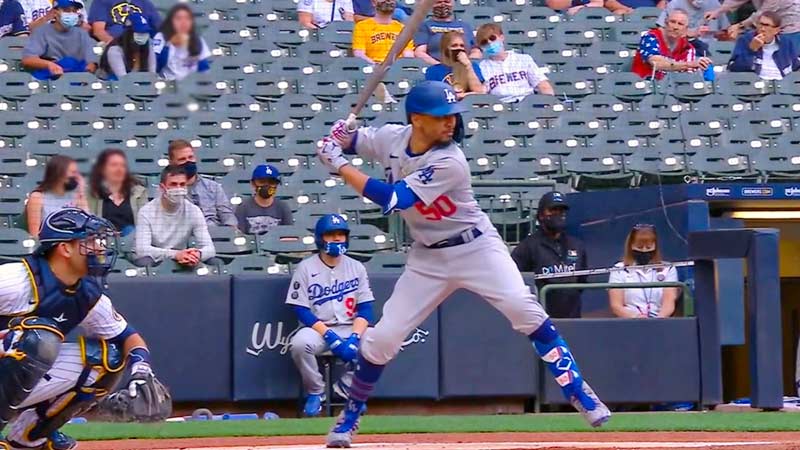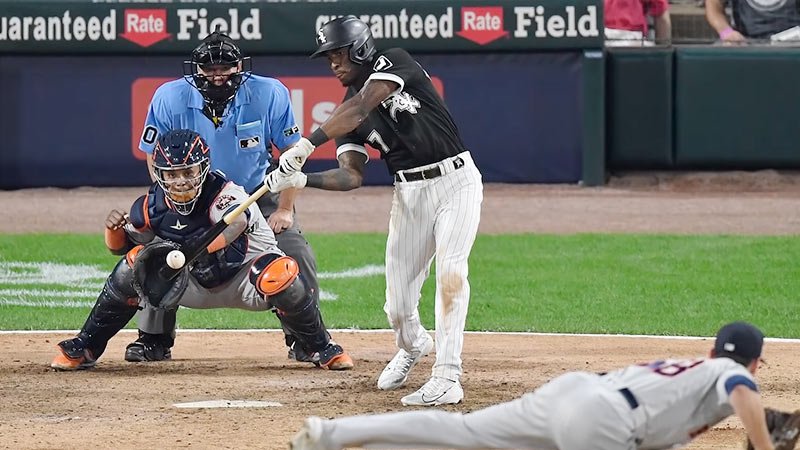In the world of baseball statistics, the debate between OPS (On-base Plus Slugging) and traditional batting average is a longstanding one.
As fans, analysts, and team decision-makers seek to understand a player’s offensive prowess, the question remains: Which metric provides a more accurate and comprehensive evaluation?
In this blog post, we embark on a journey to dissect whether is OPS better than the batting average.
We explore the roles these statistics play in assessing a player’s hitting abilities, strengths, and limitations, and how they can be used in tandem to provide a well-rounded evaluation.
We dive into the significance of power-hitting, plate discipline, and contextual analysis.
Whether you’re a seasoned baseball enthusiast or a newcomer to the sport, this exploration will shed light on the fascinating world of baseball statistics and help you appreciate the multifaceted nature of player evaluation. So, stay focused.
What Is OPS in Baseball?
To understand different baseball scenarios, you need to learn OPS baseball’s meaning. OPS in baseball stands for “On-base Plus Slugging.”
It’s a statistic that combines a player’s on-base percentage (OBP) and slugging percentage (SLG) to provide a more comprehensive measure of a player’s offensive performance. The formula for OPS is simple:
OPS = OBP + SLG
On-base percentage (OBP) measures a player’s ability to reach base, including hits, walks, and hit-by-pitches, while slugging percentage (SLG) reflects a player’s power-hitting ability by taking into account extra-base hits like doubles, triples, and home runs.
A higher OPS indicates a more productive offensive player. OPS is a valuable tool for evaluating a player’s overall offensive contribution and is often used to compare players’ batting abilities.
It provides a more holistic perspective than individual stats like batting average or home runs alone, offering a well-rounded view of a player’s effectiveness at the plate.
The Basics of the Batting Average in Baseball

The batting average is a fundamental statistic in baseball that measures a player’s hitting proficiency. Here are some key basics about batting average:
Calculation
The batting average is calculated by dividing the number of hits a player has by their total number of at-bats.
The formula is Batting Average = Hits / At-Bats. For example, if a player has 100 hits in 300 at-bats, their batting average would be .333 (or 33.3%).
Significance
Batting average is an important metric for evaluating a player’s ability to make contact with the ball and get on base.
It’s a measure of consistency and efficiency in getting hits. A high batting average is typically a sign of a skilled and reliable hitter.
Comparison
Batting average is often used to compare players and assess their performance.
It’s one of the traditional “Triple Crown” stats, along with home runs and runs batted in, and is a common component in evaluating a player’s overall offensive contribution.
However, it doesn’t account for walks, power hitting, or other offensive factors, so it’s usually considered alongside other statistics like on-base percentage (OBP) and slugging percentage (SLG) for a more complete picture of a player’s batting skills.
Is Ops Better Than Batting Average?
Whether OPS is better than the batting average depends on the context and what aspect of a player’s offensive performance you want to evaluate. Here are some points to consider:
Comprehensive Measure
OPS combines a player’s on-base percentage (OBP) and slugging percentage (SLG), providing a more well-rounded view of their offensive abilities.
While batting average only considers hits, OPS accounts for walks, extra-base hits, and overall power, giving a more comprehensive evaluation of a player’s performance at the plate.
Power and Plate Discipline
OPS is particularly valuable in assessing a player’s power and plate discipline, which are not reflected in the batting average.
A player with a high OPS may be contributing significantly in terms of extra-base hits and walks, even if their batting average is not exceptionally high.
This makes OPS a more informative stat for assessing a player’s ability to drive in runs and extend innings.
Context Matters
OPS may be better in some situations, but not all. In certain cases, a high batting average might be more critical, such as when a team needs consistent contact hitting or when a player excels at moving baserunners.
OPS is a useful tool for a broader analysis, but it should be considered alongside other stats like batting average, depending on the specific needs of the team or the context of the evaluation.
Balanced Approach

Many baseball analysts and teams prefer a balanced approach, considering both OPS and batting average, as well as other statistics like on-base percentage (OBP) and slugging percentage (SLG).
By examining a combination of these metrics, a more complete picture of a player’s offensive performance can be obtained, allowing for a more nuanced evaluation.
Batting Average Vs OPS
To understand whether ops is better than batting average or not, you need to learn ops vs batting average.
Batting average and OPS are two important statistics in baseball, each offering a distinct perspective on a player’s offensive performance. Here’s a comparison between the two:
Measure of Consistency vs. Overall Offensive Impact
- Batting Average: This statistic primarily measures a player’s consistency in making contact with the ball. It only considers the ratio of hits to at-bats, providing a simple and traditional way to assess a player’s ability to get on base through base hits.
- OPS: OPS, on the other hand, provides a more comprehensive view of a player’s offensive impact. It combines a player’s on-base percentage (OBP) and slugging percentage (SLG), considering not only base hits but also walks, extra-base hits, and power-hitting ability.
OPS evaluates a player’s overall offensive contribution, including their ability to get on base and drive in runs.
Power and Plate Discipline
- Batting Average: Batting average doesn’t account for power-hitting or plate discipline, focusing solely on singles, doubles, triples, and home runs.
- OPS: OPS takes into account both power and plate discipline. It reflects a player’s ability to hit for extra bases (doubles, triples, and home runs) and their propensity to draw walks.
This makes OPS especially valuable for assessing a player’s power-hitting skills and on-base skills, providing a more well-rounded offensive assessment.
Context-Dependent Evaluation
- Batting Average: The batting average is often more suitable for evaluating specific situations that require consistent contact hitting and advancing baserunners, such as in late-game scenarios or with runners in scoring position.
- OPS: OPS is useful for a broader assessment of a player’s offensive abilities and is particularly valuable in situations where power-hitting, run production, and on-base skills are essential. It offers a more versatile tool for assessing a player’s offensive impact in various contexts.
Balanced Approach
Many analysts and teams take a balanced approach by considering both batting average and OPS, as well as other statistics like on-base percentage (OBP) and slugging percentage (SLG).
This comprehensive evaluation allows for a more well-rounded understanding of a player’s offensive performance, taking into account both consistency and overall impact on the game.
The Case for OPS in Baseball

OPS (On-base Plus Slugging) is an important statistic in baseball with several compelling advantages in evaluating a player’s offensive performance. Here’s the case for OPS:
Comprehensive Assessment
OPS provides a more comprehensive evaluation of a player’s offensive abilities compared to traditional stats like batting average.
It combines a player’s on-base percentage (OBP) and slugging percentage (SLG), taking into account not only base hits but also walks, extra-base hits, and power-hitting capability.
This comprehensive approach provides a more holistic view of how a player contributes to the team’s offense.
Incorporates Power and Plate Discipline
OPS is particularly valuable for assessing a player’s power and plate discipline. While batting average focuses solely on base hits, OPS considers the player’s ability to hit for extra bases and their capacity to draw walks.
This makes OPS a versatile tool for evaluating both the player’s power-hitting skills and their ability to get on base, highlighting their role in driving in runs and extending innings.
Useful for Player Comparison
OPS is effective for comparing players from different eras or positions, providing a more level playing field.
It helps analysts and fans assess players’ offensive contributions and understand their relative strengths and weaknesses.
OPS is a valuable tool in debates about Hall of Fame eligibility, player rankings, and MVP discussions, as it allows for more meaningful comparisons beyond traditional stats like batting average.
Flexibility in Strategic Analysis
Teams use OPS to make strategic decisions in various game situations. It helps determine lineup orders, substitutions, and offensive strategies, as it highlights which players are more likely to contribute to run production.
OPS can also influence decisions in player acquisitions and trades, helping teams identify players who can bolster their offensive capabilities.
The Role of OPS and Batting Average in Baseball
OPS and batting average are both important statistics in baseball and they each play distinct roles in assessing a player’s offensive performance:
Batting Average
- Role: The batting average is a fundamental statistic that measures a player’s consistency in making contact with the ball. It quantifies a player’s ability to get base hits, specifically singles, doubles, triples, and home runs, relative to their total at-bats.
- Strengths: The batting average provides a clear and simple measure of a player’s ability to hit the ball and reach base through base hits. It is particularly useful for evaluating a player’s ability to advance baserunners and make contact in crucial game situations, such as with runners in scoring positions.
- Limitations: The batting average has limitations as it doesn’t account for walks, power-hitting ability, or on-base skills. It can sometimes provide an incomplete picture of a player’s overall offensive impact.
OPS (On-base Plus Slugging)
- Role: OPS is a more comprehensive statistic that combines a player’s on-base percentage (OBP) and slugging percentage (SLG) to provide a broader evaluation of offensive performance. It encompasses a player’s ability to get on base (through hits and walks) and their power-hitting capability.
- Strengths: OPS offers a well-rounded assessment of a player’s offensive contribution by considering both their ability to reach base and their capacity to hit for extra bases. It accounts for walks and power-hitting, highlighting a player’s power and plate discipline.
- Limitations: While OPS is more comprehensive, it is not without its limitations. It still doesn’t provide a complete picture of a player’s skills, such as base-stealing ability, situational hitting, or defensive contributions.
Complementary Roles
OPS and batting average are often used in conjunction with other offensive statistics like on-base percentage (OBP), slugging percentage (SLG), and runs batted in (RBI) to gain a more complete understanding of a player’s offensive prowess.
Each statistic contributes a unique aspect to the player’s overall performance evaluation.
Teams and analysts use a combination of these statistics to make informed decisions about player selection, lineup construction, and in-game strategies.
FAQs
What does baseball OPS mean?
OPS, or On-base Plus Slugging, is a baseball statistic that combines a player’s on-base percentage (OBP) and slugging percentage (SLG) to provide a more comprehensive measure of a player’s overall offensive performance.
What are the similarities in ops vs average?
OPS and batting averages both assess a player’s offensive abilities, but they measure different aspects.
Batting average focuses solely on hits relative to at-bats, while OPS considers on-base ability and power by combining OBP and SLG, offering a broader evaluation of a player’s performance.
Which state is more valuable for assessing a player’s ability to get on base consistently?
Batting average focuses specifically on hits and their frequency, making it the primary stat for evaluating consistent contact hitting.
OPS, while valuable, combines various offensive aspects, including walks and power, offering a broader perspective beyond pure consistency.
Does OPS give more weight to power hitters compared to players with a high batting average?
Yes, OPS places a greater emphasis on power-hitting and plate discipline.
Players with a high OPS tend to be strong in power-hitting and getting on base through walks, which is important for run production, even if their batting average isn’t as high.
Can OPS be used for comparing players from different eras effectively?
Yes, OPS is a useful tool for comparing players from different time periods because it provides a standardized metric that considers various offensive aspects.
It helps analysts and fans evaluate players’ overall offensive impact beyond the limitations of traditional stats like batting average.
Wrapping Up
In the ever-evolving landscape of baseball statistics, OPS and batting averages continue to be valuable tools for evaluating a player’s offensive performance.
While OPS provides a broader perspective by considering power hitting and plate discipline, batting average remains an essential indicator of consistency and situational hitting.
Both metrics have their roles to play. OPS may be favored for its comprehensive approach, but batting average retains its significance in specific game situations.
To truly understand a player’s offensive prowess, a balanced approach is key.
By combining OPS, batting average, and other relevant stats, we gain a more holistic view of a player’s abilities.
As we continue to appreciate the intricacies of America’s pastime, these statistics stand as essential companions, helping us unravel the mysteries of the game. Thank you so much.







